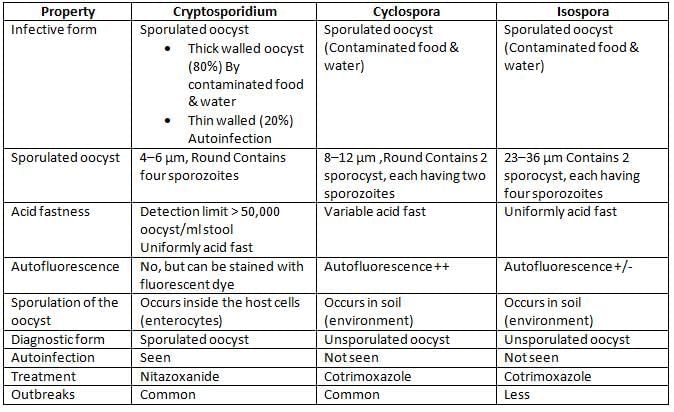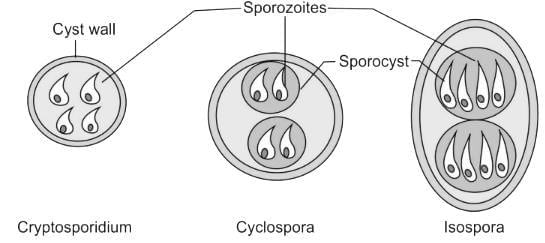NEET PG Exam > NEET PG Notes > Microbiology > Chapter Notes: Coccidian Parasites
Coccidian Parasites Chapter Notes | Microbiology - NEET PG PDF Download
Coccidian Parasites
- Toxoplasma gondii
- Sarcocystis lindermanii
- Cryptosporidium parvum
- Cyclospora cayetanensis
- Isospora belli
Toxoplasma Gondii
Life Cycle
- Present across the globe, capable of infecting various animal species.
- Exists in three distinct shapes: oocyst that has sporulated, tachyzoites shaped like crescents, and cysts in tissues holding bradyzoites.
- All three shapes can cause infection.
- Cats and other felines serve as the definitive hosts.
- Humans and other mammals such as goats and sheep act as intermediate hosts.
- Ways of transmission include:
- The most frequent way is consuming sporulated oocysts from soil, food, or water that is contaminated.
- Consuming cysts in tissues with bradyzoites from meat that is not fully cooked.
- Through transfusion of blood or transmission from mother to child, where tachyzoites cause infection.
- Oocyst that has sporulated changes into tachyzoites that reproduce quickly in the bloodstream, eventually forming cysts in tissues with bradyzoites as the dormant phase, settling in different body parts.
Clinical Features
Congenital toxoplasmosis:
- 1st Trimester: Infection is more severe.
- 3rd Trimester: Higher chance of passing the infection to the baby.
- If the Mother has been infected before: The fetus usually does not show symptoms.
- Incidence: About 1 in every 1000 live births.
- Common features:
- Chorioretinitis
- Cerebral calcification
- Convulsions
- Microcephaly
- Mental retardation
- Most frequent symptom: Chorioretinitis.
- Diagnosis:
- IgM: Detected in fetal blood; IgA can also be tested (this is experimental but has better sensitivity).
- Toxoplasma Antigen: Can be found in amniotic fluid; PCR can detect Toxoplasma genes.
In Adults: Generally asymptomatic; most common symptom is swollen cervical lymph nodes.
In HIV Patients:
- Association rate is between 15% to 40%.
- Most common symptom: Encephalitis.
- Most affected area: Brainstem.
- Occurs when CD4 count is less than 100 cells/µl.
- Other symptoms: Lung infections and chorioretinitis.
Diagnosis
- Microscopy:
- Blood smear: Comma-shaped Tachyzoites (shows active infection).
- Biopsy smear from organs: Tissue cyst with bradyzoites (indicates a past or ongoing infection).
- Antibody detection:
- Sabin Feldman test:
- Gold standard method: Very sensitive and specific but can't tell the difference between recent and past infections.
- Patient's serum mixed with live tachyzoites and complement, then treated with methylene blue and incubated.
- Antibodies in the patient's serum attach to tachyzoites with the help of complement, causing the tachyzoites to become distorted and lose color.
- Other methods include ELISA, IFA, PCR, and Animal Inoculation.
- Sabin Feldman test:
Treatment
- For adults who are immunocompetent: Treatment is not necessary.
- For toxoplasmosis in pregnancy: The preferred drug is spiramycin.
- For patients positive for HIV:The preferred drug is cotrimoxazole.
- For primary prophylaxis:
- Initiated in AIDS cases with toxoplasma when CD4 is below 100 per microliter.
- Stopped if there is response to antiretroviral therapy and CD4 exceeds 200 per microliter for three months.
- For secondary prophylaxis, which is ongoing maintenance treatment:
- Initiated when CD4 is below 200 per microliter.
- Stopped if the patient has no symptoms and CD4 plus T exceeds 200 per microliter for six months.
- For primary prophylaxis:
Comparison of Coccidian Parasites Causing Diarrhea in Immunocompromised Host


The document Coccidian Parasites Chapter Notes | Microbiology - NEET PG is a part of the NEET PG Course Microbiology.
All you need of NEET PG at this link: NEET PG
|
75 docs|5 tests
|
FAQs on Coccidian Parasites Chapter Notes - Microbiology - NEET PG
| 1. What are coccidian parasites and how do they affect immunocompromised hosts? |  |
Ans. Coccidian parasites are a group of protozoan parasites belonging to the class Coccidia. They can cause gastrointestinal infections, particularly in immunocompromised hosts such as those with HIV/AIDS, cancer, or organ transplants. These parasites invade the intestinal epithelium, leading to symptoms such as diarrhea, abdominal pain, and dehydration, which can be severe in individuals with weakened immune systems.
| 2. What is Toxoplasma gondii and what role does it play in immunocompromised individuals? |  |
Ans. Toxoplasma gondii is an intracellular protozoan parasite that can cause toxoplasmosis. In immunocompromised individuals, such as those with HIV/AIDS, it can lead to severe neurological complications, ocular issues, and gastrointestinal symptoms. Reactivation of latent infections is common in these patients, making it a significant concern for their health.
| 3. How do coccidian parasites like Cryptosporidium and Isospora differ from Toxoplasma gondii in terms of transmission and symptoms? |  |
Ans. Cryptosporidium and Isospora are coccidian parasites primarily associated with enteric infections, often transmitted through contaminated water or food. Symptoms typically include watery diarrhea, abdominal cramps, and nausea. In contrast, Toxoplasma gondii is mainly transmitted through undercooked meat or cat feces and can cause a broader range of symptoms, including flu-like illness and neurological manifestations in immunocompromised individuals.
| 4. What diagnostic methods are used to identify coccidian infections in immunocompromised patients? |  |
Ans. Diagnostic methods for identifying coccidian infections include microscopy, where stool samples are examined for oocysts; serological tests that detect antibodies; and molecular techniques such as PCR (polymerase chain reaction) to identify specific DNA sequences of the parasites. These methods help in confirming the presence of parasites and guiding appropriate treatment.
| 5. What treatment options are available for infections caused by coccidian parasites in immunocompromised patients? |  |
Ans. Treatment options for infections caused by coccidian parasites vary by the specific parasite. For Toxoplasma gondii, pyrimethamine and sulfadiazine are commonly used. For Cryptosporidium, nitazoxanide may be effective, while Isospora infections are typically treated with trimethoprim-sulfamethoxazole. Supportive care, including hydration and electrolyte management, is also crucial for these patients.
Related Searches















